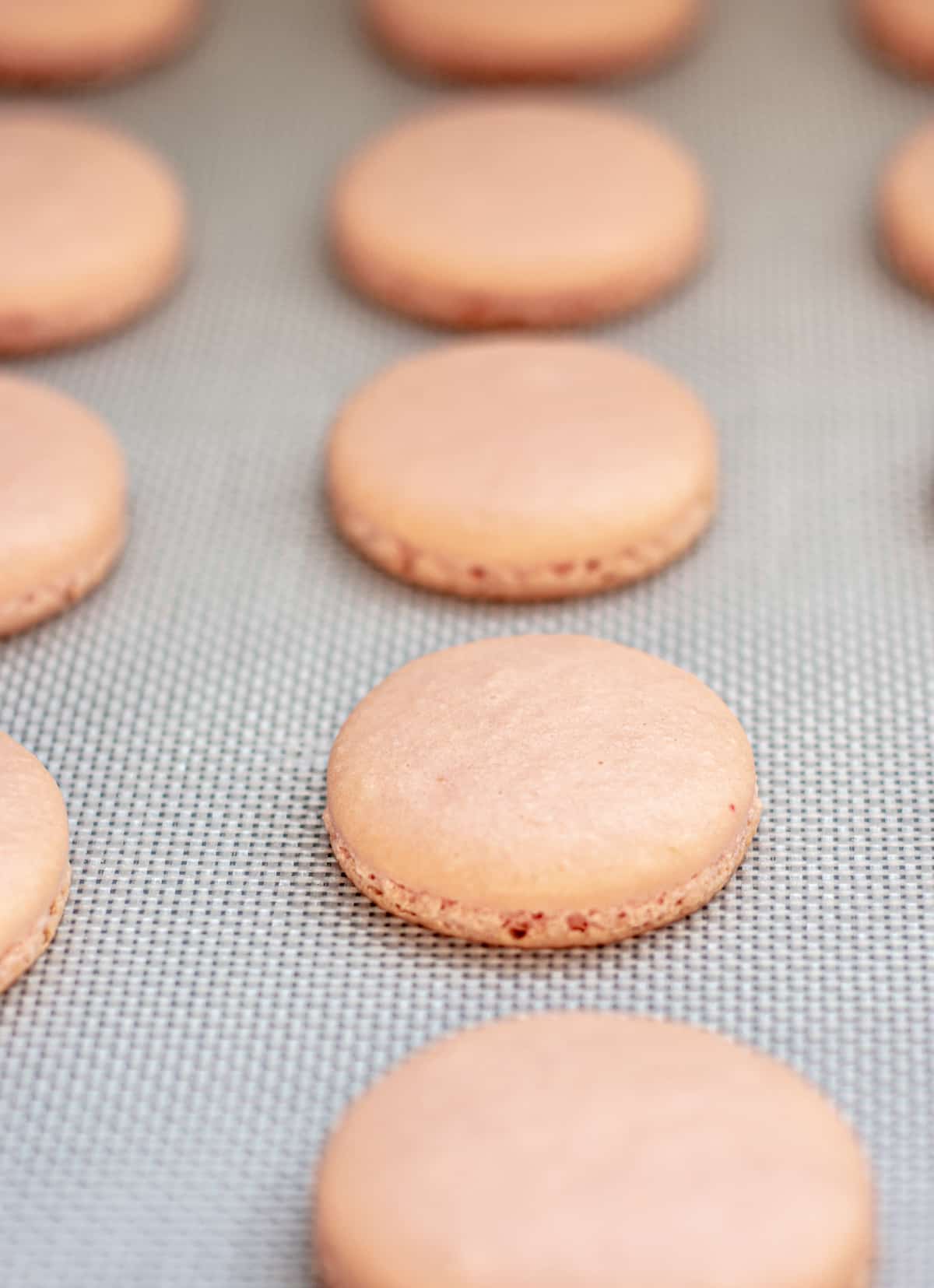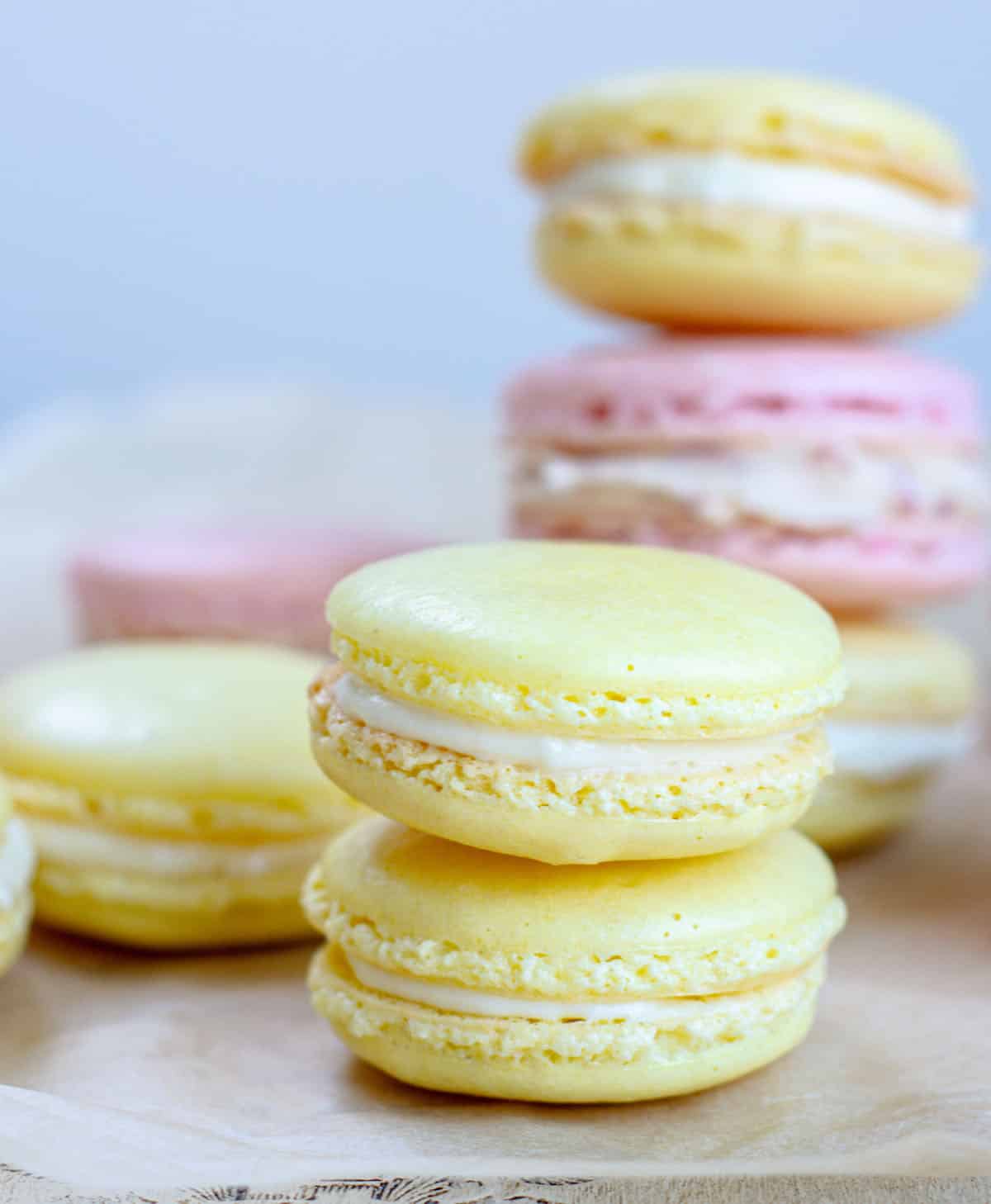Easy Macaron Recipe Step by Step
This is an easy macaron recipe for sweet French maracons. These chewy cookies can be sandwiched together with your favorite filling.
Once you’ve got this simple recipe down, you can create endless color and flavor combinations. This is a simple macaron recipe and makes a basic French macaron.

Homemade Macarons vs Homemade Macaroons
A macaron biscuit is made from a mixture of egg whites, sugar, and almond meal. It’s a cookie with a glossy top that cracks when you bite into it. The interior is chewy and soft. The macaron shell itself is mildly flavored. It is the filling in the middle that gives each macaron a unique flavor.
This simple macaron recipe is not to be confused with macaroons. They are completely different cookies. Macaroons are made with shredded coconut.
A macaron is meringue-style but with more texture. The base ingredients are egg whites, sugar, and almond meal.
Are macarons gluten-free?
Yes! Macarons are gluten-free cookies.

An Easy Macaron Recipe
To make a consistent macaron cookie there are a few steps to follow. The first is measuring your ingredients correctly.
For this recipe, it’s advised to use the gram amounts specified. Cups vary in size and so does the scooping technique used. Measuring in weight with a scale rather than volume takes away this variable.
Eggs also vary in size, so measure your egg whites. Any leftover egg yolks can be used in lemon curd, which happens to make a great macaron filling.
Egg Whites For Macarons – Do They Need Ageing?
Ageing egg whites is something that is often recommended when making meringue. This is because older egg whites whip up quicker than fresh.
However it can be hard to know at what stage your egg whites are so the addition of cream of tartar will help give them the volume they need even if your eggs are fresher. Just ensure the egg whites are at room temperature.
The Almond Meal and Confectioners Sugar
Ground almonds are a key ingredient in macarons. You can use blanched or un-blanched almonds, but un-blanched will make a rustic macaron with the little brown flecks of almond skin.
The almond meal is sieved to ensure no lumps or too big pieces. Finely ground almond meal usually passes through a sieve fairly easily and doesn’t leave too much behind. If using course almond meal, blend it first in a food processor along with confectioners sugar until smooth.
Then sieve it. If you have a very powerful blender take care you don’t over blend and heat the almond meal too much. Otherwise the almond meal will become too oily and stick together.

The Egg Whites
The egg whites are whipped with the cream of tartar until they are just holding a soft peak. Slowly white granulated sugar is added, a tablespoon at a time until the egg white has firm, glossy peaks and sugar grains can no longer be felt when the mixture is rubbed between your fingers.
Stop beating once it gets to this stage so you do not over whip the egg whites.

Macaronage
What is macaronage?
Macaronage is the term for the folding of the egg whites and almonds, and the state the batter needs to achieve. It is a key step in a good macaron. The mixture should resemble thick flowing lava, that falls in ribbons. Under-mixing the batter results in grainy macarons with pointed tops, while under-mixing will cause them to spread too much.
Tip 1/3 of the almond mixture into the egg whites and fold it together. Don’t whisk it in, use a spatula to fold it over itself until it is well incorporated. Add in the remaining almond meal and continue folding it until you achieving thick flowing ribbons. You should be able to draw an 8 in the mixture that dissolves back into the batter after 10 seconds.
Adding colors – If adding color to your macarons, use gel colorings as they will bring less moisture into the batter. The color can be added during the macaronage stage. Only use a few drops.

Piping the Macarons
Line two cookie trays with parchment paper or Silpat mats. Use a dab of macaron batter to stick the parchment paper to the cookie tray.
Insert a ¼-inch round nozzle in a piping bag and fill the bag with the macaron mixture. Alternatively use a zip lock bag with a corner cut off. The macarons won’t be as consistent but it still works.
Pipe 1-inch (2.5cm) macaron circles onto the parchment paper. Point the piping bag directly down onto the parchment paper or mat when piping. You can free-hand them or initially draw an outline on the underside of the parchment paper as a guide.
Whack the cookie tray two or three times on the bench to remove any large air holes in the batter.
Forming a Macaron Skin
To help achieve that crispy macaron shell, let the macaron sit out and form a bit of skin. Leave them to sit for about 40 minutes (or longer if it’s a humid day) until they no longer stick to your finger when touched.
Baking the macarons
Once the stickiness has gone, they can be baked. Macarons are baked at a low oven temperature so the egg whites don’t brown, or rise too fast and crack.
Oven temperatures vary depending on the oven, so finding the perfect macaron temperature takes practice. In a standard oven, a temperature of around 284 °F-300°F (140°C-150°C) is what you’re aiming for.
The macarons need to rise slowly so their tops crisp up evenly and the bottom of the macarons ruffle and form what is known as ‘macaron feet’
Keep an eye on them while they are baking. If they are browning too fast or the ‘feet’ are spreading out too much then your oven may be too hot and you should turn it down a little more.
Leave the cooked macarons to cool before carefully peeling them off the baking sheet.

Filling the Macarons
Macarons can be filled with all sorts such as buttercream, curd, jam, or ganache. Chocolate ganache is a good option for a filling that isn’t too sweet, so it goes well with the sweet macaron shells.
Basic Macaron Ganache
- 150ml pouring cream
- 200 grams of chocolate (dark, milk, or white chocolate)
Break the chocolate into small pieces and place it into a heatproof bowl.
In a saucepan heat the cream until just starting to simmer. Pour the hot cream over the chocolate and let it sit for 5 minutes before stirring it together. Once stirred, pour it into a bowl and place it in the fridge to cool. Removing it every 15 minutes to stir it will speed up the cooling process.
Once it is very thick it can be piped on one macaron shell, then sandwiched together with another macaron shell.
Macarons taste best after they have sat and ‘cured’ for 24 hours. This softens and flavors the shells better. Macarons can be stored in the fridge for up to a week or frozen for up to three months.

Why not try some other sweet baking recipes like this rhubarb and custard tart recipe.
Interested in learning some other useful recipes? Try this guide on how to make cultured butter from scratch.

Easy Macaron Recipe Step by Step
Ingredients
- 100 g ground almonds
- 180 g confectioners sugar
- 90 g egg whites
- ¼ tsp cream of tartar
- 50 g granulated white sugar
Instructions
- Sieve the almond meal and confectioners sugar into a bowl. If using coarse almond meal, blend it first in a food processor along with confectioners sugar until smooth. Then sieve it. If you have a very powerful blender take care you don’t over-blend and heat the almond meal too much. Otherwise, the almond meal will become too oily and stick together.
- Whip the egg whites and cream of tartar until soft peaks form. Add in the white sugar, a tablespoon at a time, and keep whipping until stiff peaks form and you can't feel grains of sugar when you rub a little between your finger.
- Tip approximately ⅓ of the almond mixture into the egg whites and fold it together. Don't whisk it in, use a spatula to fold it over itself until it is well incorporated. Add in the remaining almond meal and continue folding it until you achieve thick flowing ribbons. You should be able to draw an 8 in the mixture that dissolves back into the batter after 10 seconds.
- Spoon the mixture into a piping bag fitted with a 1/4 inch round tip and line two cookie trays with parchment paper or Silpat mats. Use a dab of macaron mixture to keep the parchment paper stuck down on the tray. Pipe 1-inch (2.5cm) circles on the baking sheets. Once piped, bang the tray on the bench once or twice to remove any air bubbles.
- Leave the macarons to sit out for about 40 minutes until they are no longer sticky when touched.
Preheat a standard oven to around 284°F – 300 °F (140°C -150 °C). If using a convection/fan-forced oven, start lower, at 266 °F (130°C ). You’ll need to test your own oven and find the exact perfect temperature that works for your oven. - Bake the macarons for around 15-17 minutes. Do keep an eye out as they bake, and tweak the oven temperature if needed. Once baked, remove them from the oven and leave them to cool completely before peeling off the baking paper. Sandwich together with your favorite filling. (See a basic ganache recipe in the notes below).
- Macarons taste best after they have sat and 'cured' for 24 hours. This softens and flavors the shells better. Macarons can be stored in the fridge for up to a week or frozen for up to three months.
Notes
200gof chocolate (dark, milk, or white chocolate) Break the chocolate into chunks and place it into a heat-proof bowl. In a saucepan heat the cream until just starting to simmer. Pour the hot cream over the chocolate and let it sit for 5 minutes before stirring it together. Once stirred, place it in the fridge to cool. Removing it every 15 minutes to stir it will speed up the cooling process.
Once it is very thick and scoop-able, it can be piped on one macaron shell, then sandwiched together with another macaron shell.






I have never made these cookies. I followed your step by step and they turned out wonderfully. I was afraid to pipe, found it quite easy. Fast to become a favorite.